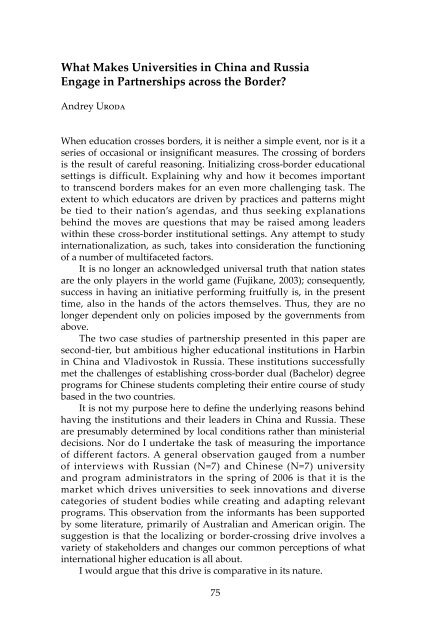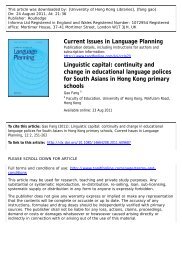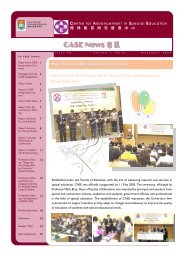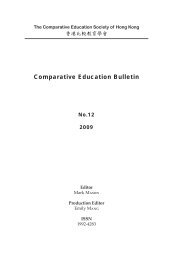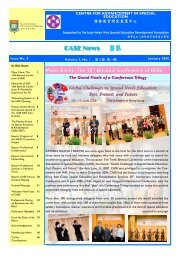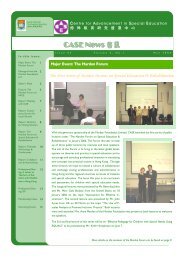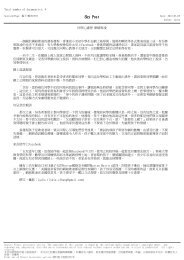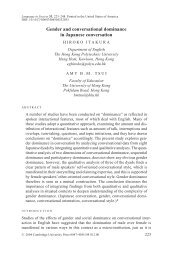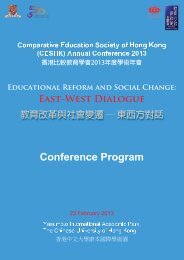Comparative Education Bulletin - Faculty of Education - The ...
Comparative Education Bulletin - Faculty of Education - The ...
Comparative Education Bulletin - Faculty of Education - The ...
Create successful ePaper yourself
Turn your PDF publications into a flip-book with our unique Google optimized e-Paper software.
What Makes Universities in China and Russia<br />
Engage in Partnerships across the Border?<br />
Andrey Uroda<br />
When education crosses borders, it is neither a simple event, nor is it a<br />
series <strong>of</strong> occasional or insignificant measures. <strong>The</strong> crossing <strong>of</strong> borders<br />
is the result <strong>of</strong> careful reasoning. Initializing cross-border educational<br />
settings is difficult. Explaining why and how it becomes important<br />
to transcend borders makes for an even more challenging task. <strong>The</strong><br />
extent to which educators are driven by practices and patterns might<br />
be tied to their nation’s agendas, and thus seeking explanations<br />
behind the moves are questions that may be raised among leaders<br />
within these cross-border institutional settings. Any attempt to study<br />
internationalization, as such, takes into consideration the functioning<br />
<strong>of</strong> a number <strong>of</strong> multifaceted factors.<br />
It is no longer an acknowledged universal truth that nation states<br />
are the only players in the world game (Fujikane, 2003); consequently,<br />
success in having an initiative performing fruitfully is, in the present<br />
time, also in the hands <strong>of</strong> the actors themselves. Thus, they are no<br />
longer dependent only on policies imposed by the governments from<br />
above.<br />
<strong>The</strong> two case studies <strong>of</strong> partnership presented in this paper are<br />
second-tier, but ambitious higher educational institutions in Harbin<br />
in China and Vladivostok in Russia. <strong>The</strong>se institutions successfully<br />
met the challenges <strong>of</strong> establishing cross-border dual (Bachelor) degree<br />
programs for Chinese students completing their entire course <strong>of</strong> study<br />
based in the two countries.<br />
It is not my purpose here to define the underlying reasons behind<br />
having the institutions and their leaders in China and Russia. <strong>The</strong>se<br />
are presumably determined by local conditions rather than ministerial<br />
decisions. Nor do I undertake the task <strong>of</strong> measuring the importance<br />
<strong>of</strong> different factors. A general observation gauged from a number<br />
<strong>of</strong> interviews with Russian (N=7) and Chinese (N=7) university<br />
and program administrators in the spring <strong>of</strong> 2006 is that it is the<br />
market which drives universities to seek innovations and diverse<br />
categories <strong>of</strong> student bodies while creating and adapting relevant<br />
programs. This observation from the informants has been supported<br />
by some literature, primarily <strong>of</strong> Australian and American origin. <strong>The</strong><br />
suggestion is that the localizing or border-crossing drive involves a<br />
variety <strong>of</strong> stakeholders and changes our common perceptions <strong>of</strong> what<br />
international higher education is all about.<br />
I would argue that this drive is comparative in its nature.<br />
75


